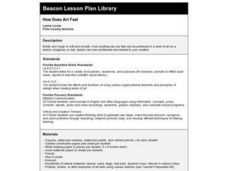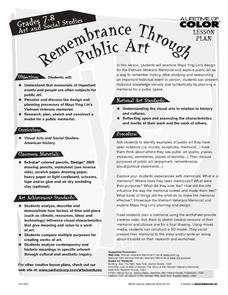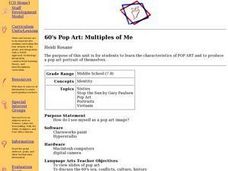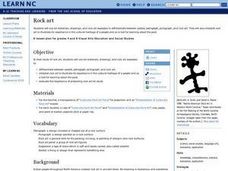Curated OER
How Does Art Feel
Students examine a variety of textures, one of the seven elements of design. They experiment with various media and techniques to produce different textures. Then they produce two works of art, one using actual textured material and one...
Curated OER
Changes in Western Art: From Realism To Cubism"
Middle schoolers discover the influences of mid 19th and early 20th century art styles: Realism, Impressionism, Post / Neo Impressionism, Fauvism, Cubism through an analysis of styles, subject matter, and media.
Curated OER
Highlights of Modern American Family Art and Literature
Students develop imagery in literary and art works. They discuss Jacob Lawrence's painting, the "Tombstones, 1942", which conveyed overcrowded tenements and families living in Harlem (New York, New York). They design picture stories...
Curated OER
Art and Literature: What's the Point?
Eleventh graders analyze the social/political purpose(s) of art and literature. They create written and visual texts that bring attention to a social/political concern. Presentation and discussion of art and literature in connection with...
Curated OER
Art Lesson: My Symbol
Students explore and brainstorm the concept of symbols in real world applications and create a poem describing themselves. They design and paint a symbol that represents him/herself utilizing the technique of simplification to express...
Curated OER
Creating Artwork to Explain Environmental Change
High schoolers review artwork that relates to the environment and communicates a value. They view and analyze art by Andy Warhol, Eric Carle and Albert Bierstadt and then create original pieces with an environmental theme.
Curated OER
Exploring Photographs: Methods of Visual Analysis
Students use the methods of description, reflection, and formal analysis for a study of images. In this image analysis activity, students work in teams to interpret and analyze an assigned work of art. Students write responses to the...
Curated OER
Remembrance Through Public Art
Students discuss the purpose of public art, in the form of memorials. They research the design and planning of the Vietnam War Memorial in Washington D.C., then plan their own memorial and construct a 3D model.
Curated OER
Art, Inc.
Students are connecting the year that their piece of art was created with the historical events happening in America at that time. They also conduct research to prepare for looking into Art History.
Curated OER
Portable Art Portfolio
Students create an electronic art portfolio. In this visual arts lesson, students use a pen drive and save a digital image of the projects they made in art class. Students view a Powerpoint presentation at the end of the year of their...
Curated OER
Fusing Furniture And Asian Art
Students see how French artists used imported lacquer panels in their furniture. They explore Asian lacquer panels and create their own Asian-inspired lacquer panel design. They incorporate their classmates' designs into a new furniture...
Curated OER
Geometry in Art
Learners recognize and measure geometric shapes within abstract art. They examine quilts for shapes and they each make their own quilt from squares using geometry and measurement.
Curated OER
Art and Influence of Theatre
Students examine an 18th century drawing and produce a skit based on the drawing. In this art analysis lesson, students analyze the story depicted in a drawing and create a skit inspired the scene. Students research the 18th century...
Curated OER
Environment As Art
Students create an idea for environmental artwork for installation somewhere on school property.
Curated OER
60's Pop Art: Multiples of Me
Students discover characteristics of Pop Art through slides and discussion of the 60's era and produce a pop art portrait of themselves using Clarisworks paint program and Hyperstudio.
Curated OER
Rock art
Students study rock art they use art materials, colored photographs and rock art examples to: differentiate between symbol, petroglyph, pictograph, and rock art. They interpret rock art to illustrate its importance in the cultural...
Curated OER
Modern Art Styles of Matisse
Pupils study the history of Matisse as an artist and focus upon his influences upon the style of art that he was famous for. The learners perform research about the life and works. Then they create a work of art that is similar to the...
Curated OER
Performance into Art
Learners explore two works of art of performance art. In this performance art lesson, students analyze performance art in the examples of Yves Klein and Joseph Beuys. Learners complete image based discussion activities. Students research...
Curated OER
Create Your Own Lucky Charm
Learners create their own lucky charms. For this St. Patrick's Day lesson, students discuss symbols of luck. Learners make their own lucky charms out of clay.
Curated OER
Looking at French Decorative Arts: Makers of Nothing, Sellers of Everything
Young scholars imagine they are a 'marchand-mercier' (or salesman) and write a persuasive letter to sell French items. In this art analysis lesson plan, students identify the role of a 'marchand-mercier' and write a three-paragraph...
Curated OER
Choosing and evaluating a range of subject matter, symbols, and ideas
Art is a great way to convey or express an idea. Learners choose an idiom, draw it, and use transfer paper to create photograms. They discuss how why they chose the phrase they did, and how they expressed that idea through their drawings.
Curated OER
Plaster Sculpture – subtractive method
Practice the subtractive sculpture process with your class. They'll discuss the subtractive method, art form and space, then design a sculpture which they will create from a block of plaster. Technical instructions are included.
Curated OER
Black and White Still Life
There isn't a lot to this lesson, but it could provide some guidance. It outlines a five-day drawing lesson where learners view a presentation on the importance of drawing in art history, practice pencil skills, and compose a black and...
Curated OER
Graph Paper Patterns
Young artists divide a piece of graph paper into sections using rectangles, squares, and triangles. They then fill each section with patterns of shape and color. Elementary graders describe how their patterns are organized. Secondary...

























